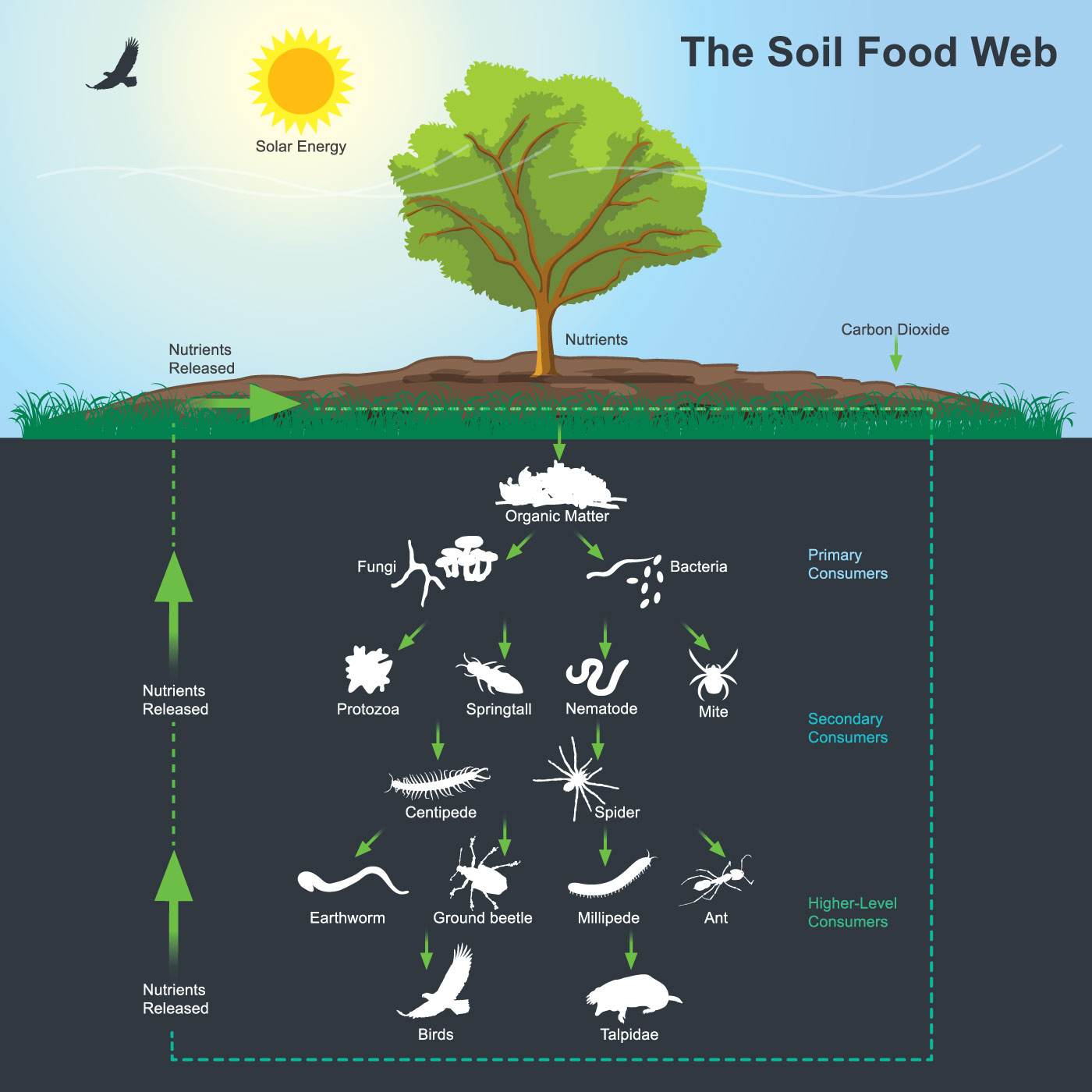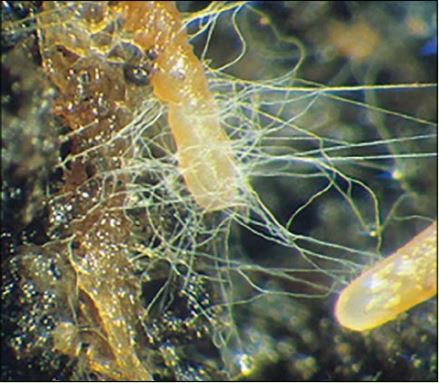Whole Tree Organic Mulch and the Soil Food Web
One of the best ways we can have a healthy variety of plants in our landscapes is to use organic mulch to replicate the natural, nutrient cycling processes that takes place on our Midwestern forest floors.
The plant communities in our Midwestern forests, in large part owe their long-term health to an abundance of soil organic matter that is created and maintained by an interconnected web of biological activity both on and below the soil surface.
It follows the logic that increasing amounts of soil organic matter supports a healthy soil food web which in turn supports a diverse set of healthy plants. So, why not do our part to be good stewards of this process in our own landscapes?
At Bluestone Organic, we know it’s important to be environmental stewards. We strive to minimize our ecological footprint by utilizing the byproduct of our activities – natural wood material – in an effective and sustainable manner – in the making of whole tree organic mulch.
Our whole tree organic mulch is a sustainable product that uses only local trees from Bluestone Tree’s residential tree removal and pruning service. This allows us to be a private facility and gives us complete control of the trees we process into high quality, natural organic mulch. We only work with clipped tree parts from the whole tree with no added fillers, plants, grasses, wood pallets, CCA treated lumber, or construction wood waste that is found within many dyed mulches on the market.
What About Bark Mulch?
While there are minimal amounts of tree bark in our organic mulch, we do not exclusively produce bark mulch. Bark mulch is often used in landscapes based largely on aesthetics. Dyes are often used to make bark mulch visually appealing with a soil-like color to justify its use. Because without it, much of the fill material in bark mulch in the form of reclaimed wood waste from pallets, CCA treated lumber or the construction industry would not look as appealing nor be of any interest due to its potentially harmful content.
In addition, bark mulch is produced and shipped far from the place of purchase – leaving the discerning land manager or homeowner without the choice of a far less carbon emission intensive way to mulch their landscapes.
Suberin and Clumping Mulch
Lastly, tree bark contains a waxy substance, called suberin, that acts like a water repellent to keep water in the tree and to protect the inner parts of the tree from unwelcome water-borne pathogens that may lead to disease. Due to suberin, bark mulch will form a crust-like layer on the surface which causes water to runoff instead of it being readily absorbed and stored for plant use over time. Therefore, mulch produced from the entire tree makes the suberin in bark insignificant, and when ground down the inner wood will absorb and release moisture more slowly and act as a water storage instead of a water repellent.
Have you ever wondered why forests can thrive indefinitely without a single use of artificial fertilizers, pesticides, herbicides or fungicides?
The Benefits of Whole Tree Organic Mulch
In addition to our whole tree mulch being sourced and produced locally and absorbing and releasing water rather than repelling it – it replenishes plant nutrients by building and maintaining soil organic matter while increasing soil biology, aeration, structure, and drainage over time. Because the whole tree is used in making our mulch, we are doing more to mimic the natural decomposition processes in our Bloomington & Midwestern forests when we apply it.
Have you ever wondered why forests can thrive indefinitely without a single use of artificial fertilizers, pesticides, herbicides or fungicides? The cyclical processes on forest floors provide an active and stable nutrient bank as the organic matter breaks down and becomes available to plants. Plants can tap into this nutrient bank to get what they need to be healthy and offer in return nutrients in the form of exudates to soil microbes in their root zone. It is a symbiosis, or partnership, that aligns many biological interests of soil.
For example, microscopic fungi and bacteria are primary decomposers that create the large and small size soil aggregates that reduce compaction and build structure in soil. Protozoa and nematodes feed on fungi and bacteria and release plant available nutrients as they do it. Larger organisms such as microarthropods, and even larger, such as worms and beetles, create air pockets, or aerate, as they tunnel and burrow their way through soil foraging on protozoa and nematodes. A web of interactions that creates a habitable environment for a gamut of soil species as they persist through time.
Sustainability
Using Bluestone Organic’s whole tree organic mulch is a sustainable activity. Not only does its continued use work to cycle local resources in a safe and reliable manner, its decomposition produces a wealth of nutrients in the form of active and stable sources of soil organic matter for the plants in our landscape to enjoy. Our whole tree mulch in combination with our nutrient dense and humus rich compost – which we intend to inform our customers of and offer soon – will do well to provide a healthy plant habitat for years to come.



